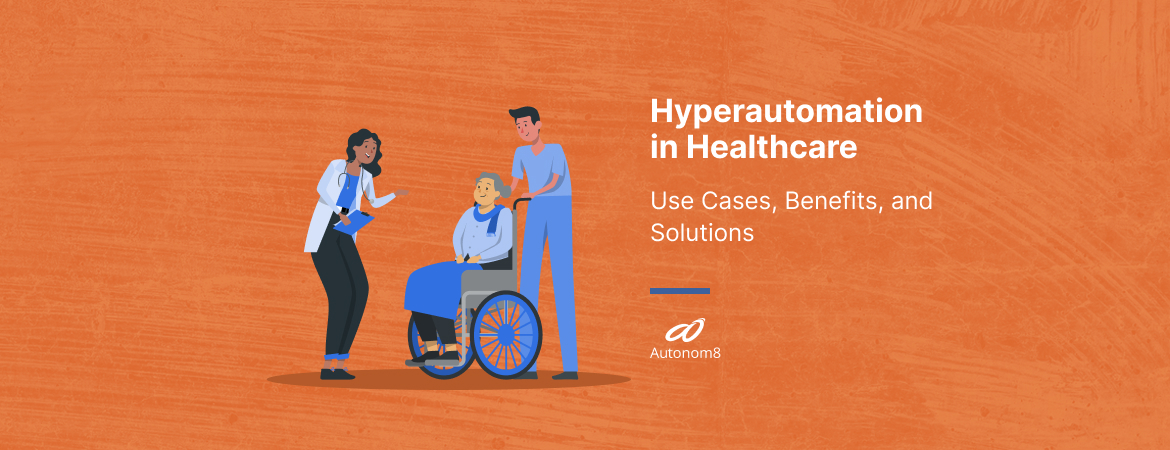Hyperautomation in Healthcare: Use Cases, Benefits, and Solutions


Before we dive into the merits and benefits of hyperautomation in healthcare, let’s take a few snippets from our previous posts for some background. Hyperautomation, simply put, as we had mentioned in our Guide to Hyperautomation, is the integration of advanced technologies, including artificial intelligence (AI), machine learning (ML), robotic process automation (RPA), and Low-code and no-code (LCNC), to automate complex and time-consuming tasks. This combination of multiple technologies is expected to see further advancements in 2023, leading to broader implementation and usage across industries, including hyperautomation in banking, insurance, retail, education, and healthcare.
With this in mind, several market reports have also reported that the global healthcare industry is expected to spend over $11 billion on hyperautomation technologies by 2023. This is a significant increase from the $4.5 billion spent in 2018, demonstrating the growing importance of hyperautomation in the healthcare sector. The study also found that healthcare organizations are increasingly turning to hyperautomation to help improve operational efficiency, reduce costs, and improve patient outcomes.
Since the onset of the COVID-19 pandemic, studies have noted the accelerated customer demand for the digital delivery of patient care.
Related article: A Practical Guide to Implementing Hyperautomation Into Your Enterprise
Amongst its numerous use cases, here are a few listed below –
Hyperautomation platforms allow administrators to access granular, relevant data to eliminate manual efforts, improve productivity and predict future demands.
Clinical decision support systems (CDSS) use AI algorithms to analyze patient data and provide real-time recommendations for diagnosis, treatment, and management. According to a report by Accenture, the use of CDSS can reduce medical errors and can have a positive impact on patient outcomes and the overall healthcare ecosystem.
Medical imaging analysis involves using AI algorithms to analyze medical images such as X-rays, CT scans, and MRI scans to diagnose and treat various conditions. A study by the Journal of Digital Imaging found that AI algorithms can improve diagnostic accuracy by over 90% compared to traditional methods.
EHRs use RPA and ML to automate the process of data entry and retrieval, making it easier for healthcare providers to access patient information. According to a report by the Office of the National Coordinator for Health Information Technology, the use of EHRs can reduce data entry errors by over 50% and improve patient safety.
AI algorithms are used to analyze vast amounts of data related to drug discovery and development, including molecular structures, chemical properties, and clinical trial results. According to a report by Deloitte, AI-powered drug discovery can reduce the time and cost of drug development by up to 50%.
Telemedicine refers to using technology to provide medical consultations and treatments remotely. A report by the World Health Organization found that telemedicine can improve access to healthcare services for patients in remote or underserved areas by over 60%.
Gartner, a leading research and advisory company, predicts that by 2025, hyperautomation will be the leading driver of digital transformation in the healthcare industry.
According to Gartner, the use of hyperautomation technologies will help healthcare organizations to improve efficiency, reduce costs, and enhance patient outcomes while also helping to address the growing shortage of healthcare staff in many regions.
Hyperautomation in healthcare can bring several benefits, including:
By automating complex processes such as medical imaging analysis and clinical decision support, hyperautomation can help healthcare providers to make more accurate diagnoses and treatment decisions, leading to improved patient outcomes.
By automating manual and repetitive tasks such as data entry and retrieval, hyperautomation can help healthcare providers to save time and increase efficiency, freeing up more time for patient care.
Hyperautomation can help to reduce medical errors by automating the analysis of medical data and providing real-time recommendations for diagnosis and treatment.
Telemedicine, a type of hyperautomation in healthcare, can help to improve access to care for patients in remote or underserved areas by enabling them to receive medical consultations and treatments remotely.
By streamlining processes and reducing medical errors, hyperautomation can help healthcare providers to save costs and allocate resources more effectively.
Hyperautomation can help healthcare providers to better manage large amounts of medical data by automating data entry and retrieval, making it easier to access and analyze patient information.
Hyperautomation can help to enhance research and development in healthcare by automating the analysis of vast amounts of data related to drug discovery and development.
Hyperautomation has the potential to bring significant benefits to the healthcare sector, and Autonom8 works hard every day to incorporate it into our workflow solutions. The A8iQ workflow management platform for Healthcare can save hospitals precious time and money by improving patients’ experience, and get them treated quickly, and making the hospital run smoothly and efficiently. Our low-code platform enables the rapid creation and deployment of automated customer journeys that can cut administrative costs and elevate your patient experience. A few of the myriad services our platform allows you to automate include
Our users are pleased with the platform’s process automation abilities and customer service. Learn more about the hyperautomation platform for healthcare and start your trial today and watch your healthcare-providing workflows improve!
Hyperautomation is typically used to describe the integration of advanced technologies, such as AI, ML, NLP, and others, to automate a wide range of business processes. These processes include those that humans traditionally perform.
Hyperautomation is useful when integrated into all verticals, including healthcare. Some of the use cases include medical imaging analysis, telemedicine, and clinical decision support, amongst others.
Hyperautomation is a disciplined, business-driven approach that organizations use to quickly identify, examine and automate as many business and IT processes as possible.
Integrating hyperautomation into healthcare allows for improved patient outcomes, increased efficiency, the reduced scope for medical errors, and aids with cost savings.
Fill in your details and our executive will get in touch within 48 hours
Fill in your details and our executive will get in touch within 48 hours